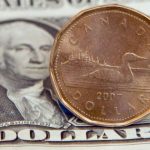US dollar traded higher and ended Fridays US session on positive territory against its Canadian counterpart, despite the fact that consumers in the United States remained less optimistic in late October, while Royal Bank of Canada embraced a more accommodative monetary policy and prices of crude oil plunged, marking their largest weekly loss since June.
USD/CAD touched a session high at 1.0461 at 17:50 GMT, also the pairs highest point since September 6th, after which the cross closed at 1.0452 on Friday, gaining 0.30%. Support was likely to be found at October 24th low, 1.0367, while resistance was to be met at September 6th high, 1.0501.
On Friday Thomson Reuters in cooperation with the University of Michigan reported that the final value of the index of consumer confidence in the United States slowed down during late October, reaching 73.2 and also marking its lowest level since December 2012. The final reading of the index in September was 77.5. Analysts had projected that this indicator will remain almost without a change in October in comparison with the preliminary value of 75.2. This result implied that consumer spending in the country may probably slow down as well. Consumer expenditures provide a considerable proportion of the US Gross Domestic Product.
At the same time, a separate report showed that durable goods orders in the United States increased at the fastest pace in three months in September, as higher demand for commercial and military aircraft neutralized the drop in business equipment. Orders rose 3.7% in September, exceeding preliminary estimates of a 2.0% increase and following the revised up 0.2% gain registered in August. Durable goods orders excluding transportation equipment dipped 0.1% in September, following the revised 0.4% drop in August (0.1% drop previously), confounding expectations of a 0.5% gain. Durable goods orders excluding defense rose 3.2% in September in line with projections after the 0.6% climb a month ago.
Meanwhile, the loonie, as Canadian dollar is also nicknamed, registered losses against the greenback for a third consecutive day, after the Royal Bank of Canada said on October 23rd that it revised down its economic growth outlook for the current year to 1.6% from 1.8% previously. Banks policy statement this week stressed on the need for future raise in the benchmark interest rate, something which has been repeated at every prior policy meeting since April 2012. The central bank updated its projection to 2015, as previously it pointed the third quarter of 2014. On the other hand, Toronto-Dominion Bank pushed back its forecast that the next rate raise will occur sometime in 2015, as previously it had predicted two interest rate increases during 2014.
Crude oil, Canadian largest export, touched its lowest point since June on Thursday. Futures on crude oil, maturing December 13th, closed at $97.87 per barrel, gaining 0.78% for the day, but recording a 2.95% weekly loss. Crude oil is Canadas largest export.
All in all, the Canadian currency has depreciated 4.1% during the year against nine developed-nation currencies, which are tracked by the Bloomberg Correlation-Weighted Index. In addition, the US dollar has increased its value by 1.6% during the same period.





